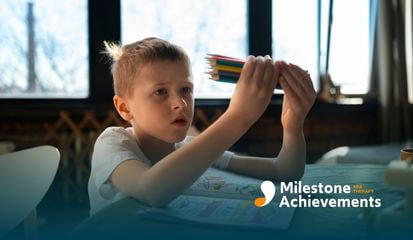
Regressive Autism: Support Strategies for Families
Discover effective support strategies for families dealing with regressive autism. Our blog offers valuable insights and tips for navigating this challenging journey.
Key Highlights
Here are the key takeaways about regressive autism:
- Regressive autism is marked by a noticeable loss of previously learned skills, such as language or social abilities.
- Early signs of this developmental regression typically appear between 15 and 30 months of age.
- The primary areas affected by autistic regression are often communication and social engagement.
- Early and personalized intervention is crucial for helping children regain skills and manage symptoms.
- A strong network of support strategies for families is essential for navigating the challenges of regressive autism.
Introduction
For parents of children, noticing a sudden loss of skills can be confusing and concerning. When a child who was developing typically begins to lose language or social abilities, it may be a sign of regressive autism. This form of autism spectrum disorder (ASD) involves a developmental regression where previously mastered milestones disappear. Understanding what regressive autism is, recognizing the signs, and knowing the available support options can empower you to help your child navigate this journey effectively.
Many families have shared personal stories about their experiences with rapid regression into autism, describing the emotional challenges and the confusion that comes with witnessing their child lose skills they once had. Such firsthand accounts can offer insight, comfort, and hope for others facing similar circumstances.
Understanding Regressive Autism in Children
Regressive autism is a condition where autistic children who appear to be developing as expected suddenly lose skills they once had. This isn't a temporary setback; it's a significant shift in their developmental path. Seeing your child’s progress reverse can be distressing, but gaining a clear understanding of the condition is the first step toward getting them the right help.
This developmental regression can affect various areas, from speech to social interaction. Exploring how regressive autism manifests, its early symptoms, and how it differs from other forms of autism can provide clarity and direction for concerned families.
What is regressive autism and how does it manifest?
Regressive autism is a form of autism spectrum disorder characterized by the loss of previously acquired skills. This autistic regression means a child who was once meeting developmental milestones, such as using words or interacting socially, begins to backtrack. It's more than just a plateau; it's a noticeable reversal in their abilities.
The signs of regression can appear in several ways. You might notice your child stops using words they once knew, withdraws from social situations, or loses interest in playing with others. This phenomenon is an actual loss of ability, not a matter of willingness. As one expert noted, "You are autistic. You were able to do a set of things, and then you find you can’t do those things anymore."
The core symptoms of autism, such as challenges with social skills and communication, become apparent after this period of skill loss. This can be a confusing time for parents, who may have had no prior concerns about their child's development. Recognizing these changes is key to seeking an early diagnosis and support.
Early signs and symptoms of regression
Pinpointing the early signs of regression is crucial for timely intervention. The most common areas where a loss of skills occurs are language and social abilities. Your child might have been babbling, forming words, or even short phrases, and then this progress suddenly halts or reverses.
This shift can also affect nonverbal communication. A child may stop making eye contact, no longer respond to their name, or lose interest in social cues they once understood. The change can be gradual or happen quickly, leaving parents wondering what went wrong.
Some specific early signs to watch for include:
- Loss of previously used words or phrases.
- Reduced eye contact and social withdrawal.
- No longer acknowledging social cues or engaging with peers.
- Reverting to infantile sounds like cooing or babbling.
Differences between regressive and non-regressive autism
The main difference between regressive and non-regressive autism lies in the onset of symptoms. With non-regressive autism, also known as early-onset autism, developmental delays are often apparent from early infancy. Parents might notice from the beginning that their child is not meeting key developmental milestones at the same pace as their peers.
In contrast, regressive autism appears after a period of typical development. Children with this type of autism seem to develop normally for their first 15 to 30 months, hitting milestones as expected. Then, they experience a sudden and significant loss of skills, particularly in language and social interaction.
Research suggests that about one-third of children on the autism spectrum experience this regression. While both paths lead to an autism diagnosis, the experience of witnessing a regression after a period of seemingly typical development can be uniquely challenging for families.
Prevalence and Age of Onset
Understanding how common regressive autism is and when it typically appears can help you know what to watch for. Developmental regression affects a significant portion of children with autism, but it doesn't happen to everyone. The age of onset is often concentrated within a specific window during early childhood.
Knowing the typical timing and statistics associated with regression provides valuable context. This information can help you better understand the patterns of skill loss and the specific areas that are most commonly affected during this critical developmental period.
Typical age range for developmental regression
The onset of regression in young children typically occurs during a specific window in early childhood. Most parents report noticing a loss of skills when their child is between 15 and 30 months of age. Studies have pinpointed the average age for this regression to be around 19 months.
This timing is particularly noteworthy because it coincides with a period of rapid developmental growth, especially in language and social skills. For many families, the regression becomes apparent during the second year of life, a time when they might have previously seen their child thriving.
Some children may show slight developmental delays even before the major regression occurs. Understanding this typical age range is crucial for early detection and intervention.
Statistical insights and trends in the United States
Statistical data helps paint a clearer picture of regressive autism's prevalence. Research indicates that approximately 25-30% of children diagnosed with autism spectrum disorder experience a regression after a period of normal development. This means that for up to one-third of children with ASD, the initial signs of the condition involve a loss of acquired skills.
Recent studies and prospective studies are shedding more light on this phenomenon. For example, some research suggests that children who experience regressive autism may have more severe core symptoms and require a higher level of support compared to those with non-regressive autism. A 2022 multi-center study highlighted this connection between regression and disease severity.
These findings emphasize the importance of tracking developmental progress closely, especially during the first few years of a child's life. As research continues, these insights will help professionals and families better understand the different pathways within the autism spectrum and tailor support accordingly.
Patterns of skill loss and affected areas
The loss of skills in regressive autism can affect multiple areas of development, but some are more commonly impacted than others. The most frequently reported areas of regression are language skills and social engagement. A child might stop using words they previously knew or lose interest in interacting with family members and peers.
While communication is a primary area of concern, other skills can also be affected. Some children may experience a decline in their motor skills, such as coordination or the ability to perform simple physical tasks. Others might show a regression in adaptive skills, which include self-care activities like feeding themselves.
Commonly affected areas include:
- Language Skills: Loss of spoken words, babbling, or phrases.
- Social Engagement: Reduced eye contact, lack of interest in peers, and social withdrawal.
- Motor Skills: Decline in fine or gross motor abilities.
- Adaptive Skills: Reversal in self-care abilities, such as using utensils.
Causes and Contributing Factors
The question of what causes regressive autism is complex, and researchers believe there isn't a single answer. Instead, it's likely a combination of genetic risks and environmental factors that contribute to its onset. This interplay makes it challenging to pinpoint one specific trigger for every child.
Understanding these potential contributing factors is an active area of research. By examining the roles of genetics, environmental influences, and the immune system, scientists hope to gain a clearer understanding of why some children experience this developmental regression while others do not.
Genetic and biological risks
Genetic factors are considered a significant contributor to the risk of autism, including its regressive form. Families with a history of autism spectrum disorder often have a higher likelihood of having a child who develops the condition. This suggests that certain hereditary traits can increase a child's susceptibility.
One specific biological area of interest is mitochondrial dysfunction. A study from the University of California, Davis, identified this as a possible cause of regressive autism. Mitochondria are the energy-producing units in our cells, and they are vital for healthy brain development. When they don't function properly, it can lead to an increase in oxidative stress and potentially contribute to developmental delays.
This research highlights how biological processes can go awry, impacting a child's development. The link between mitochondrial health and brain function continues to be an important area of study for understanding the underlying causes of regressive autism.
Environmental triggers and influences
Beyond genetics, environmental factors are also thought to play a role in regressive autism. These triggers can be diverse and may interact with a child's genetic predisposition. For example, exposure to certain infections or toxins during pregnancy is being explored as a potential influence on a child's neurodevelopment.
In early childhood, sudden changes or chronic stress can also have a meaningful impact on a child's emotional safety and development. An autistic child may need more time to adapt to new situations than a neurotypical child. What might be a minor stressor for one child could overwhelm another, potentially contributing to regression.
This is especially relevant in cases of autistic burnout, which can occur in older children and adults. Chronic stress from trying to cope without adequate support can deplete a person's emotional reserves, leading to a loss of skills. This shows how environmental pressures can directly affect an individual's abilities.
Immune system and neurodevelopmental links
The immune system is another piece of the puzzle in understanding regressive autism. Recent studies have pointed to a connection between immune system irregularities and the onset of autism spectrum disorders. Some research suggests that issues like chronic inflammation or autoimmune responses could be linked to the loss of skills seen in regression.
For instance, some scientists hypothesize that anti-brain antibodies could damage a developing fetal brain, contributing to developmental delays. Elevated levels of certain immune cells have also been found in some autistic children, highlighting the complex neurodevelopmental links between the body's defense system and brain function.
While the exact mechanisms are still under investigation, these findings suggest that the immune system's role is significant. Exploring these connections may lead to new ways of understanding and potentially treating the underlying biological factors of regressive autism.
Diagnostic Process for Regressive Autism
Receiving a diagnosis for regressive autism is not as simple as a blood test or a scan. The process involves careful observation and comprehensive evaluation by a team of specialists. Early detection is key, and it often begins with parents noticing changes in their child's behavior and skills.
The diagnostic journey for autistic regression focuses on gathering a detailed developmental history and using specialized tools to assess a child's communication, social, and behavioral patterns. Understanding this process can help you feel more prepared as you seek answers for your child.
Recognizing regression: screening tools and evaluations
The first step in diagnosing regressive autism is recognizing the signs of regression. This journey usually starts when parents or caregivers notice a loss of skills and bring their concerns to a pediatrician. From there, a professional can recommend specific evaluations to investigate further.
Screening tools are often used to identify children who may be at risk for autism spectrum disorder. One common tool is the Modified Checklist for Autism in Toddlers (M-CHAT), which helps flag early signs that warrant a more in-depth assessment. It’s important to remember that these tools are for screening, not diagnosing. They simply indicate that a closer look is needed.
If a screening suggests a need for further evaluation, a child will be referred to specialists for comprehensive assessments. These evaluations are essential for confirming a diagnosis and forming an effective plan for early intervention. Key parts of this process include:
- A detailed review of the child's developmental history.
- Direct observation of the child's behavior and interactions.
- Use of standardized screening tools.
- Hearing and vision tests to rule out other issues.
Diagnostic criteria and multidisciplinary assessments
After initial screenings, a comprehensive diagnosis is made through multidisciplinary assessments. This means a team of professionals, such as developmental pediatricians, child psychologists, and speech-language pathologists, works together to evaluate your child. This collaborative approach ensures that all aspects of your child's development are considered.
The diagnostic criteria for autism spectrum disorder are outlined in the Diagnostic and Statistical Manual of Mental Disorders (DSM-5). A diagnosis is based on observing challenges in social communication and interaction, as well as restricted or repetitive patterns of behavior. In cases of regressive autism, the history of skill loss is a key part of the evaluation, even though "regression" itself is a descriptive term rather than a formal diagnosis.
These assessments go beyond checklists and screening tools. They involve direct observation, structured play-based activities, and in-depth conversations with parents about the child’s developmental history. This thorough process helps create a complete picture of your child's unique strengths and challenges.
Challenges in pinpointing onset and underlying causes
One of the major challenges in diagnosing regressive autism is pinpointing the exact onset of regression. While some parents recall a very sudden loss of skills, for others, the changes are more subtle and gradual. A child might slowly become less responsive or lose words one by one, making it difficult to identify when the regression truly began.
Furthermore, determining the underlying causes of the regression is equally complex. As discussed, regressive autism is likely caused by a combination of genetic, environmental, and biological factors. With so many potential contributors, it's nearly impossible to isolate a single reason for any individual child's experience.
This lack of a clear timeline or a single cause can be frustrating for families seeking answers. However, the focus of the diagnostic process is less on finding a "why" and more on identifying the symptoms of autism and developing a supportive plan to help the child move forward.
Intervention and Treatment Options
Once a diagnosis is made, the focus shifts to intervention and creating effective treatment plans. The goal of these therapies is to help your child regain lost skills, develop new ones, and improve their overall quality of life. There is no one-size-fits-all approach; treatments are tailored to each child's unique needs.
From behavioral therapies like ABA therapy to specialized interventions for speech and sensory issues, there are many avenues of support. Exploring these options can help you build a comprehensive plan that gives your child the best chance to thrive.
Applied Behavior Analysis (ABA) and other therapies
Applied Behavior Analysis (ABA) is one of the most widely used and effective therapies for children with autism, including those who have experienced regression. ABA therapy is a type of behavior analysis that focuses on improving specific behaviors, such as social skills, communication, and daily living skills, through a system of rewards and reinforcement.
The success rate of ABA therapy can be high, with some sources claiming that intensive programs help many children make significant progress. Treatment plans are highly individualized, breaking down complex skills into small, manageable steps. This structured approach helps children learn and build on their successes over time.
While autism is a lifelong condition, many skills lost during regression can be regained with the right support. Early and intensive ABA therapy can help many children catch up to their peers and learn new, successful ways to adapt and engage with the world around them.
Speech, occupational, and sensory integration interventions
In addition to ABA, other specialized therapies play a crucial role in supporting children with regressive autism. Since language loss is a primary feature, speech therapy is often a cornerstone of the treatment plan. A speech-language pathologist can help your child regain communication skills or develop alternative ways to express themselves, such as using picture systems.
Occupational therapy helps children develop the skills needed for daily living. This can include anything from fine motor skills like writing to self-care tasks like getting dressed. For children with sensory sensitivities, sensory integration therapy can be particularly beneficial. This therapy helps children better process and respond to sensory input from their environment, reducing sensory overload.
Key interventions include:
- Speech Therapy: To improve verbal and nonverbal communication.
- Occupational Therapy: To build functional skills for daily activities.
- Sensory Integration Therapy: To manage sensory processing issues and reduce sensitivities.
Emerging medical and holistic approaches
The field of autism treatment is constantly evolving, with researchers exploring new medical and holistic approaches. Some emerging treatments are showing promise in addressing the symptoms of regressive autism. For example, one study investigated the use of a combination of corticosteroids and a flavonoid called quercetin.
In this study, some participants showed marked improvements in social interaction and receptive language skills after the treatment. Importantly, none of the children experienced a re-regression after the follow-up period, suggesting that such medical interventions may have lasting effects for some individuals.
While these emerging treatments are encouraging, it's important to approach them with caution and always consult with a medical professional. Ongoing research is essential to validate these findings and ensure they are safe and effective. These studies represent a hopeful direction for future therapies.
Support Strategies for Families
Navigating a diagnosis of regressive autism can be an emotional journey for the entire family. It's important to remember that you are not alone and that building a strong support system is just as crucial as your child's treatment plan. Finding the right resources can provide practical help and much-needed emotional support.
From professional guidance to community connections, there are many ways to get the help you need. Leaning on support groups, educating yourself, and prioritizing your family's mental health can make a world of difference as you move forward.
Building a support network: professionals and community resources
Creating a robust support network is a vital step for families dealing with regressive autism. This network should include a team of trusted professionals, such as your child’s therapists, doctors, and educators, who can provide expert guidance and coordinate care.
Beyond professional help, connecting with community resources can provide invaluable support. Organizations like the Autism Society and Autism Speaks offer a wealth of information, from educational materials to links to local chapters and events. These groups can help you feel connected and empowered with knowledge.
Here are some ways to build your support network:
- Connect with local autism chapters and support groups.
- Join online forums and social media groups for parents of autistic children.
- Attend workshops and informational sessions offered by advocacy organizations.
- Build strong relationships with your child's therapy and school team.
Coping techniques for parents and siblings
The emotional toll of watching your child regress can be immense for parents of children with autism. It's essential to prioritize your own mental health and find healthy coping techniques to manage the stress.
Allowing yourself to feel a range of emotions—from grief to hope—is a normal part of the process. Seeking emotional support from a therapist or counselor can provide a safe space to process these feelings.
Siblings also face unique challenges. They may feel confused, overlooked, or frustrated. It's important to maintain open lines of communication with them, explain their sibling's condition in an age-appropriate way, and carve out one-on-one time to make them feel seen and valued.
Connecting with other families in similar situations can be incredibly comforting. Sharing experiences and advice with those who truly understand can reduce feelings of isolation and provide a sense of community. Remember, taking care of yourself and your entire family is not selfish; it's necessary for long-term resilience.
Advocacy, education, and ongoing learning
Becoming an advocate for your child is one of the most powerful things you can do. This means learning to navigate the educational and healthcare systems to ensure your child receives the services and accommodations they need. Advocacy involves speaking up in school meetings, questioning treatment plans, and fighting for your child's rights.
Continuous education is a key part of effective advocacy. The more you learn about autism, therapies, and your child's unique needs, the more confident you will feel in your decisions. Organizations like the Autism Society provide resources to help you stay informed about the latest research and best practices.
Ongoing learning also helps you adapt as your child grows and their needs change. By staying engaged and informed, you can be a proactive and effective partner in your child's developmental journey, ensuring they have every opportunity to succeed.
Conclusion
In conclusion, regressive autism poses unique challenges for families, but understanding the condition can lead to effective support strategies. By recognizing the early signs, knowing the causes, and being aware of various treatment options, families can create a nurturing environment that fosters growth and development.
Building a strong support network and utilizing coping techniques can significantly alleviate stress for both parents and siblings. Remember, you are not alone in this journey. There are numerous resources available to guide you through the complexities of regressive autism.
If you're looking for personalized advice or assistance, reach out today to connect with professionals in Milestone Achievements who can help.
Sources:
- https://www.autismparentingmagazine.com/what-is-regressive-autism/
- https://pmc.ncbi.nlm.nih.gov/articles/PMC4949854/
- https://www.medicalnewstoday.com/articles/regression-in-autism
- https://www.autismspeaks.org/expert-opinion/regression-autism
- https://www.healthline.com/health/autism/what-is-regression-in-autism
- https://www.sciencedirect.com/topics/medicine-and-dentistry/regressive-autism
- https://bmcpsychiatry.biomedcentral.com/articles/10.1186/s12888-024-05955-1
- https://www.frontiersin.org/journals/psychiatry/articles/10.3389/fpsyt.2022.809543/full


Partner with us on your child's journey
Milestone Achievements offers evidence-based ABA therapy to help children with autism reach their full potential. Together we’ll set meaningful goals and celebrate progress every step of the way.
Start ABA Services Today


